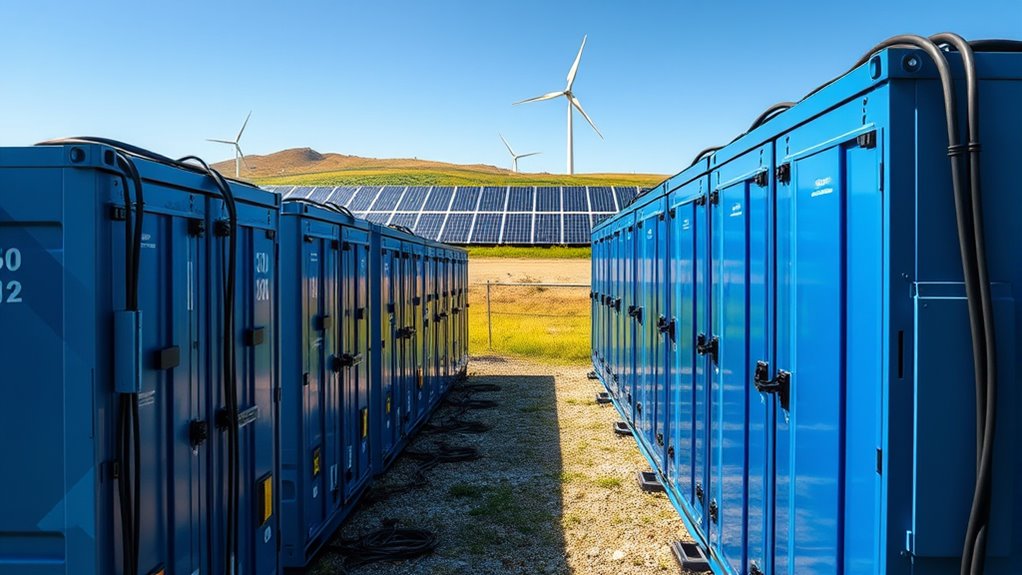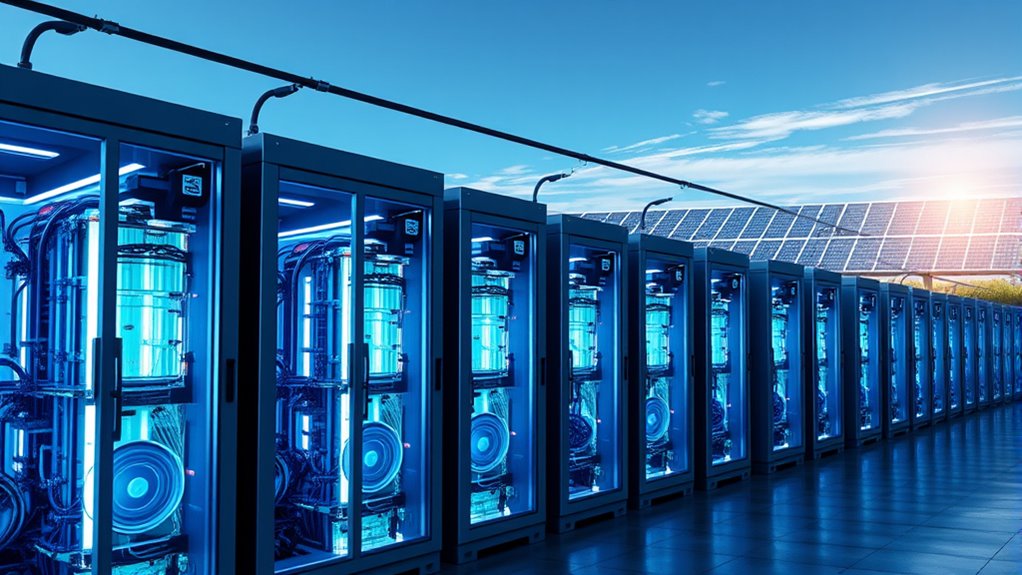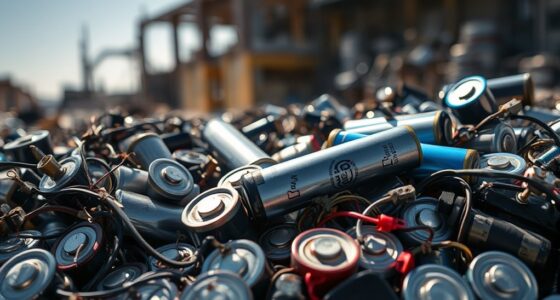Second-life batteries help support renewable energy integration by storing excess power from solar and wind sources when supply exceeds demand. They then release this stored energy when generation is low or demand is high, stabilizing the grid. Using repurposed batteries also reduces waste and environmental impact while lowering costs. This sustainable approach makes renewable energy more reliable and scalable. Keep exploring to discover how these batteries enable a cleaner, more resilient energy future.
Key Takeaways
- Second-life batteries store excess renewable energy, smoothing out fluctuations and supporting consistent power supply.
- They help mitigate the intermittent nature of solar and wind sources, enabling reliable renewable energy integration.
- Reusing batteries reduces reliance on fossil-fuel backup plants during renewable energy variability.
- Recycling and repurposing materials from second-life batteries lower environmental impact and resource extraction needs.
- They enhance grid stability and resilience, facilitating the broader adoption of renewable energy systems.

As renewable energy sources like solar and wind become more prevalent, the need for efficient energy storage grows. Second‑life batteries play a pivotal role in this landscape by providing a sustainable, cost-effective way to store excess energy generated during peak times. These batteries, repurposed from electric vehicles or other applications, help smooth out power supply fluctuations, guaranteeing a more stable grid. When you consider battery recycling, it’s clear that second‑life batteries extend the lifespan of existing resources, reducing waste and minimizing the environmental impact. Instead of discarding used batteries, reusing them for energy storage keeps valuable materials circulating longer and lessens the demand for new battery production, which can be resource-intensive. Utilizing Free Floating battery systems can further enhance the flexibility and scalability of energy storage solutions for diverse applications.
By integrating second‑life batteries into the energy system, you contribute directly to grid stability. These batteries can absorb surplus energy when production surpasses demand, then release it during periods of low generation or high consumption. This balancing act prevents grid overloads and blackouts, making your energy system more reliable. Their ability to absorb and dispatch energy on demand also aids in managing the intermittent nature of renewable sources like solar and wind, which are inherently variable. You’ll notice that as these batteries are deployed, they help mitigate the need for fossil-fuel backup plants, reducing greenhouse gas emissions and supporting the transition to cleaner energy.
Battery recycling becomes an essential part of this process because it ensures that the batteries used for second life are sourced responsibly. Recycling helps recover valuable materials such as lithium, cobalt, and nickel, which are indispensable for manufacturing new batteries. This closed-loop approach not only lowers the environmental footprint but also keeps costs down, making renewable energy integration more economically viable. You can think of second‑life batteries as a bridge—extending the utility of existing technology while fostering a more circular economy in energy storage. As more communities and utilities adopt these batteries, they will see improved grid resilience, greater energy independence, and a step closer to a sustainable future.
In essence, second‑life batteries support renewable energy integration by offering a reliable, eco-friendly storage solution that enhances grid stability. When paired with effective battery recycling practices, they maximize resource efficiency and help build a resilient, sustainable energy system that’s ready to meet future demands. You’re part of this transition, helping to create a cleaner, more reliable energy landscape for generations to come.
Frequently Asked Questions
What Are the Environmental Impacts of Second-Life Batteries?
You should know that second-life batteries have some environmental impacts, mainly related to recycling challenges and supply chain considerations. As these batteries are repurposed, there’s a risk of hazardous waste if not properly managed. Additionally, sourcing and transporting used batteries can create environmental footprints. However, extending their lifespan reduces waste and raw material extraction, helping to lower overall environmental harm when managed responsibly.
How Cost-Effective Are Second-Life Batteries Compared to New Ones?
You’ll find second-life batteries are like a treasure chest compared to new ones, offering a cost comparison that’s hard to beat. They’re incredibly cost-effective, often slashing expenses and revealing massive economic benefits. By reusing batteries, you drastically reduce costs while boosting sustainability. This smart choice means you save money and support greener energy, making second-life batteries a savvy, budget-friendly alternative that outshines brand-new options every time.
What Safety Measures Are Necessary for Second-Life Battery Use?
You should follow strict safety standards when using second-life batteries to prevent hazards. Regularly inspect and test batteries for damage or degradation, and guarantee proper Battery recycling procedures are in place to handle end-of-life units safely. Use appropriate protective gear during maintenance, and install monitoring systems to detect potential issues early. Adhering to safety standards minimizes risks and promotes safe, reliable deployment of second-life batteries in renewable energy applications.
How Long Do Second-Life Batteries Typically Last?
Ever wondered how long your second-life batteries can last? Typically, they serve well for 5 to 10 years, but battery degradation varies based on usage and maintenance. Lifespan estimation depends on factors like cycle count and operating conditions. While they may not match new batteries’ longevity, with proper care, your second-life batteries can efficiently support energy needs during their extended life, giving you reliable renewable energy storage for years to come.
Are Second-Life Batteries Scalable for Large Renewable Projects?
Yes, second-life batteries are scalable for large renewable projects, but you should be aware of scalability challenges such as ensuring consistent quality and managing diverse battery chemistries. To overcome these issues, focus on effective integration strategies like modular systems and advanced monitoring. These approaches help optimize performance, extend lifespan, and make large-scale deployment more feasible, supporting renewable energy’s reliable and efficient integration into the grid.
Conclusion
Second‑life batteries act as the backbone of renewable energy, turning discarded power packs into valuable assets that bridge the gap between supply and demand. They’re like a well-tuned orchestra, harmonizing fluctuating energy flows into a steady, reliable rhythm. By embracing these batteries, you’re not just recycling; you’re fueling a sustainable future. Together, they light the way toward a greener tomorrow, transforming waste into a powerful force for change.










